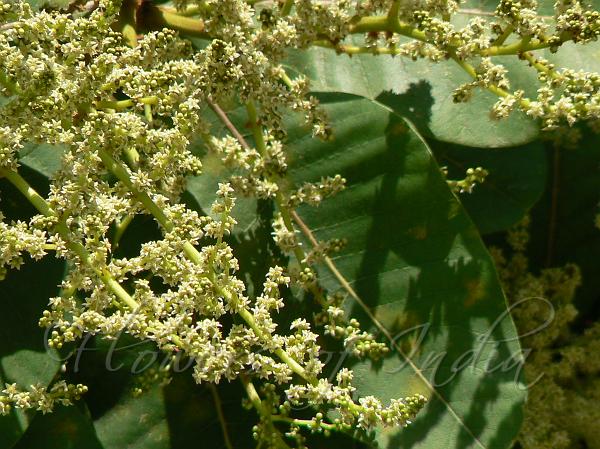|
| Chironji Tree |
|

|

| File size | 1630785 |
| Original date | 12/26/07 1:44 PM |
| Resolution | 2048 x 1536 |
| Flash | Flash did not fire, auto |
| Focal length | 72.0mm |
| Exposure time | 1/400s |
| Aperture | 6.3 |
| Focus Distance | |
| Metering Mode | Multi-segment |
| Camera make | Panasonic |
| Camera model | DMC-FZ7 |
| Sensor type | OneChipColorArea |
|
|
|
|
Photo: |
Botanical name: Buchanania lanzan Family: Anacardiaceae (Cashew family)
Synonyms: Spondias elliptica, Buchanania latifolia, Lanzana solitaria
Synonyms: Spondias elliptica, Buchanania latifolia, Lanzana solitaria
Chironji Tree is a medium-sized deciduous tree, growing to about 50 ft
tall. It bears fruits each cotaining a single seed, which is popular
as an edible nut, known as chironji. It is common in our forests
mostly in eroded ravine lands. It avoids waterlogged areas, but occurs
locally in clay soils. It can be identified by the dark grey crocodile
bark with red blaze. A good species for afforesting bare hill slopes. It
has tickly leathery leaves which are broadly oblong, with blunt tip and
rounded base. Leaves have 10-20 pairs of straight, parallel veins.
Pyramidal panicles of greenish while flowers appear in early spring.
Fruits ripen from April to May and remain on the tree for quite a long
time. Chironji Tree is found in Indian Subcontinent to China (S. Yunnan) and Indo-China, including Western Himalaya, at altitudes of 150-2000 m.
Flowering: January-March.
Medicinal uses: The roots are acrid, astringent, cooling,
depurative and constipating, and are useful in treatment of diarrhoea.
Leaves are used in the treatment of skin diseases. Fruits are used in
treating cough and asthma.
The roots are acrid, astringent, cooling,
depurative and constipating, and are useful in treatment of diarrhoea.
Leaves are used in the treatment of skin diseases. Fruits are used in
treating cough and asthma.
Medicinal uses:
 The roots are acrid, astringent, cooling,
depurative and constipating, and are useful in treatment of diarrhoea.
Leaves are used in the treatment of skin diseases. Fruits are used in
treating cough and asthma.
The roots are acrid, astringent, cooling,
depurative and constipating, and are useful in treatment of diarrhoea.
Leaves are used in the treatment of skin diseases. Fruits are used in
treating cough and asthma. | Identification credit: Hemanth Tripathi, Santosh Yadav | Photographed at Sanjay Gandhi National Park, Mumbai & Jharkhand. |
• Is this flower misidentified? If yes,